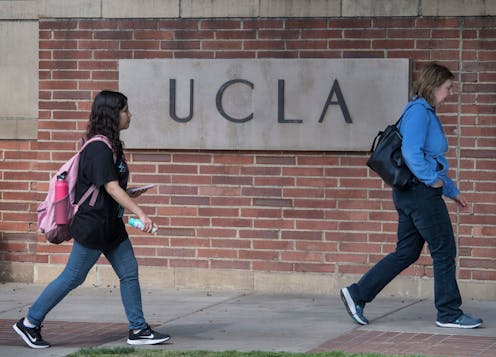What the California vote to keep the ban on affirmative action means for higher education
- Written by Vinay Harpalani, Associate Professor of Law and Henry Weihofen Professor, University of New Mexico

Editor’s note: On Nov. 3, California voters rejected Proposition 16[1], a proposed amendment to the California Constitution which would have reinstated affirmative action in the state’s public institutions. Here, Vinay Harpalani[2], an expert on affirmative action in university admissions, discusses the history of this debate in California and what the rejection of this measure in 2020 will mean for the state.
Why did California ban affirmative action in higher education?
During the 1990s, the ban was part of a larger backlash against growing racial and ethnic diversity in California[3]. Then-Governor Pete Wilson attacked affirmative action, arguing that any consideration of race was unfair discrimination[4], even if it helped underrepresented minorities. In June 1995, Governor Wilson issued an executive order[5] that began to phase out affirmative action. Shortly thereafter, the regents of the University of California voted to end the use of race[6] as a factor in admissions.
Then, in 1996, California voters approved Proposition 209[7], an amendment to the California Constitution. It fully eliminated the state government’s use of affirmative action. This effort was spearheaded by Ward Connerly[8], a prominent Black opponent of affirmative action.
Proposition 209 was named the “California Civil Rights Initiative[9]” – a very deceptive title, in my opinion. The ballot initiative used almost the same language as the Civil Rights Act of 1964[10], and many voters thought they were voting for a similar law, not a ban on affirmative action.
What was the effect of the initial ban in terms of access to higher education?
The enrollment of Black, Latino and Native American students dropped dramatically in the University of California system[11]. For example, at UCLA, the percentage of underrepresented minorities dropped from 28% to 14% between 1995 and 1998[12]. There was a similar drop at UC Berkeley.
The enrollment numbers have recovered, largely due to increased Latino enrollment. Currently at UCLA, 22% of the undergraduate student body is Latino and 3% is Black[13]. But it is also important to note that the number of Latino high school graduates has more than tripled since 1997[14].
The effect at other UC campuses is a bit more complicated. Some of the campuses saw increased racial diversity[15], not only because the Latino population grew, but also because applicants who were not admitted to UC Berkeley or UCLA would instead enroll at a different campus. Additionally, the affirmative action ban affects the California State University system, where it has impacted the ability to offer race-conscious financial aid packages[16], and California’s community colleges. In total, California’s public higher education institutions enroll over 2 million students[17].
Why doesn’t the ban conflict with Supreme Court rulings?
In Grutter v. Bollinger[18] in 2003 and Fisher v. University of Texas [19] in 2016, the U.S. Supreme Court ruled that universities have the option to use affirmative action in admissions if they want to. But it did not require them to do so, and it has actually said that universities should consider race only if they really need to in order to have a diverse student body.
Also, in another case, Schuette v. Coalition to Defend Affirmative Action[20] in 2014, the Supreme Court ruled that a state can ban affirmative action at its public universities. So while the Supreme Court has said that there is no federal constitutional violation when public colleges and universities consider race as an admissions factor on a limited basis, states can choose to make it illegal if they want to.
How will keeping the ban affect higher education in California?
It will be an impediment to racial equity. Although California’s population continues to become more diverse, the affirmative action ban prevents underrepresented minority groups from having the same educational opportunities. Race-conscious policies are especially necessary for underrepresented minorities to have access to the most prestigious institutions, such as UCLA and UC Berkeley, which open many doors for professional advancement. Also, another continuing effect in my view will be the decreased quality of education at California colleges and universities. The U.S. Supreme Court itself said that having a racially diverse student body improves education for everyone[21], including white students. The inability to consider race will mean that students of different backgrounds will have less opportunities to learn from each other.
References
- ^ On Nov. 3, California voters rejected Proposition 16 (ballotpedia.org)
- ^ Vinay Harpalani (scholar.google.com)
- ^ growing racial and ethnic diversity in California (www.washingtonpost.com)
- ^ any consideration of race was unfair discrimination (www.nytimes.com)
- ^ executive order (boardarchives.metro.net)
- ^ end the use of race (www.latimes.com)
- ^ Proposition 209 (ballotpedia.org)
- ^ spearheaded by Ward Connerly (ballotpedia.org)
- ^ California Civil Rights Initiative (ballotpedia.org)
- ^ Civil Rights Act of 1964 (www.history.com)
- ^ dropped dramatically in the University of California system (www.ets.org)
- ^ from 28% to 14% between 1995 and 1998 (www.ets.org)
- ^ 22% of the undergraduate student body is Latino and 3% is Black (www.admission.ucla.edu)
- ^ the number of Latino high school graduates has more than tripled since 1997 (edsource.org)
- ^ increased racial diversity (www.ets.org)
- ^ the ability to offer race-conscious financial aid packages (edsource.org)
- ^ California’s public higher education institutions enroll over 2 million students (regents.universityofcalifornia.edu)
- ^ Grutter v. Bollinger (www.oyez.org)
- ^ Fisher v. University of Texas (www.oyez.org)
- ^ Schuette v. Coalition to Defend Affirmative Action (www.oyez.org)
- ^ improves education for everyone (www.acslaw.org)
Authors: Vinay Harpalani, Associate Professor of Law and Henry Weihofen Professor, University of New Mexico

